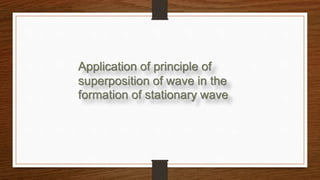
physics presentation (yukesh).pptx
- 1. Application of principle of superposition of wave in the formation of stationary wave
- 2. Presented by : [SECTION M2] Yukesh Gautam Sirson Sharma Ujjwal Shah Shreeyansh Poudel Sarthak Rijal
- 3. ACKNOWLEDGEMENT : Never let small minds convince you that your dreams are too big!! Hello and good morning to you all from my side. I Yukesh Gautam on the behalf of my team members would like to express the deep sense of gratitude to our Uniglobe college and respected teacher Mr. Saroj Baral who gave the golden opportunity to do this project. I really acknowledge your support ,effort and timely guidance which actually helped us in better understanding of the subject matter. Also, I could not forget my team members who have been so instrumental in the preparation of the project. It was totally impossible to finalize the project without you!! Really kind effort and encouragement.
- 4. TABLE OF CONTENT Introduction Types of superposition waves Stationary waves Nodes and antinodes Characteristics Conclusion
- 5. The principle of superposition of waves states that the resultant displacement of the particle is equal to the vector sum of individual displacements due to different waves. Introduction principle of superposition of waves
- 6. If y be the resultant displacement of a particle and y1, y2, . . . are displacements due to individual waves, then according to the principle of superposition of waves, we have y= y1 + y2 + y3… +yn
- 7. Superposition of wave Interference There are two types of interference of a wave. i. Constructive interference ii. Destructive interference
- 8. CONSTRUCTIVE INTERFERENCE If two waves superimposed with each other in the same phase, the amplitude of the resultant is equal to the sum of the amplitudes of individual waves resulting in the maximum intensity of light, this is known as constructive interference
- 9. Destructive Interference If two waves superimpose with each other in opposite phase, the amplitude of the resultant is equal to the difference in amplitude of individual waves, resulting in the minimum intensity of light, this is known as destructive interference.
- 11. Let y1 and y2 be the displacements of two progressive waves of same amplitude a and wave length travelling in opposite direction simultaneously with the same velocity v. The equations of these waves may be expressed as follows, y1 = a sin (ωt – kx) . . . (1) y2 = a sin (ωt + kx) . . . (2) Thus, the resultant displacement of the particle of medium due to both the waves will be determined
- 12. from the principle of superposition, = y1 + y2 = a sin (ωt – kx) + a sin (ωt + kx) = a [sin (ωt – kx) + a sin (ωt + kx)] Applying formula sinC+sinD y = 2a cos kx. sinωt y = A sinωt . . . (3) Equation (3) represents a simple harmonic wave whose amplitude is A = 2a cos kx. It is evident that, for different values of x, the amplitude will have different values. Obviously, the frequency of stationary wave is equal to the interfering waves i.e. there is no change in frequency.
- 13. Nodes and Antinodes Nodes: A node is a point along a standing wave where the wave has minimum amplitude. Antinodes: the maximum displacement takes place is called antinode The distance between any consecutive node and antinode is λ/4
- 14. 1) One easy to understand example is two people shaking either end of a jump rope. If they shake in sync, the rope will form a regular pattern with nodes and antinodes and appear to be stationary, hence the name standing wave. 2) When we press a guitar string against the fret, we are fixing one of the ends, thus causing a reflection phenomenon: when a wave formed in the string reaches the fret, it is reflected and travels backwards.
- 15. CONCLUSION : Overall, this project is the source of knowledge of Superposition of wave and its types. Again I will like to thanks our respected teacher Mr Saroj Baral for gaving us golden opportunity to participate in this project.